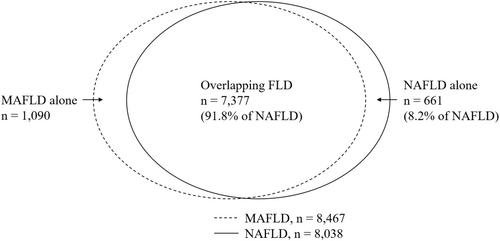Overlapping group between non-alcoholic fatty liver disease and metabolic associated fatty liver disease better for liver research
Abstract
Aims
Metabolic associated fatty liver disease (MAFLD) was proposed to replace “non-alcoholic fatty liver disease (NAFLD) with new diagnostic criteria.” The group meeting these two diagnostic criteria is called “Overlapping Fatty Liver Disease (FLD).” Its clinical characteristics remain unknown.
Methods
This study included participants from the Taiwan Bio-Bank database, where NAFLD was defined as hepatic steatosis in liver ultrasound, with exclusion of other known chronic liver diseases. MAFLD was defined as the presence of hepatic steatosis plus metabolic dysfunction, defined as having any of following three criteria: overweight/obesity, type 2 diabetes mellitus (DM), or ≥2 metabolic risk abnormalities in lean/normal weight subjects. According to these two diagnostic criteria, three groups were identified: “overlapping FLD”, “NAFLD alone”, and “MAFLD alone.” NAFLD fibrosis score (NFS) >0.675 was defined as advanced liver fibrosis.
Results
Eight thousand thirty-eight NAFLD participants (age 55.86 ± 10.12; males 41.07%) were included in the final analysis. Of them, “overlapping FLD” was diagnosed in 7377 (91.8%) and “NAFLD alone” in 661 (8.2%) participants. “Overlapping FLD” patients were older and had a higher percentage of male, worse metabolic profiles, higher NFS, and the percentage of carotid plaques was higher than those with “NAFLD alone.” Multivariate analysis showed age, hypertension, DM, and BMI were positively associated with advanced liver fibrosis in “overlapping FLD” patients.
Conclusions
“Overlapping FLD” is better for liver research due to identifying a high-risk population among NAFLD patients. NAFLD definition introduces the heterogeneity through “NAFLD alone” group and MAFLD criteria overcome this limitation.


 求助内容:
求助内容: 应助结果提醒方式:
应助结果提醒方式:


